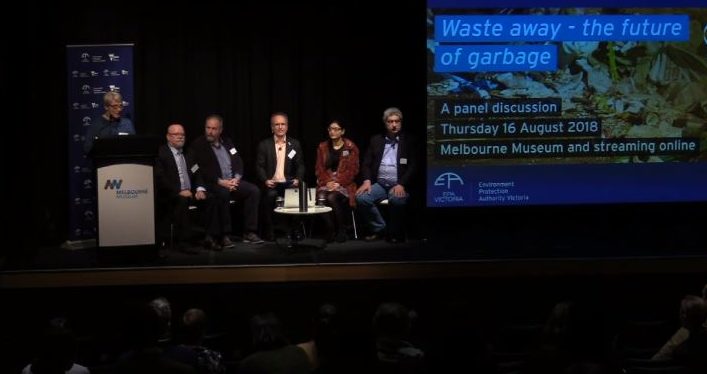Cutting Down on Waste with EPA Know-How

By Priya Mohandoss
Most of us know to ‘reduce, reuse and recycle’. Yet now, when it comes to waste, this only scratches the surface.

As part of National Science Week, EPA Victoria hosted its 3rd annual event, Waste Away – the future of garbage. EPA Chief Environmental Scientist, Dr Andrea Hinwood addressed the audience with statistics that revealed Victorians produce 12.7 million tonnes of rubbish/year with 4.2 million tonnes becoming landfill.
After her opening speech, a group of four experts, along with compere, Dr Anthony Boxshall, delved deeper to reveal their strategies on how to deal with the challenges facing the future of waste.
Here’s what they had to say:
Ruby Chan, Inventor of ‘Moducware’
Main focus: Throwaway culture affects environment
- Product design needs to be a collaborative approach with a version that is best for all parameters.
- When designing products, factors such as durable materials used in the process and how the end product will be reused need consideration. Although plastic has this quality, in terms of single-use, it could be replaced with something more viable.
- Use compostable products. Polymers that are natural can be biodegradable and used again whereas synthetic polymers create difficulties.
- Keep components such as plastic and paper separate at point of manufacture instead of splitting them after the product has been discarded.
- Concentrate on a circular economy instead of a linear approach. Therefore, generate use of waste through both biological and technical cycles.
- Resort to products that have a circular economy instead of accepting freebies from companies advertising their brand.
- Reflect on the waste impact of products and assess if it is essential, ecological and has a long shelf life. Also, evaluate if it can be repaired when broken.
Mark Glover, Director and CEO of Renewable Carbon
Main focus: Circular economy
- Economy, otherwise known as the dismal science, relies on self-interest to prosper. Yet at post-consumerism, self-interest becomes irrational. Therefore, there has to be an ethos to get marketing firms to make products more eco-friendly and allow them to thrive on advertising their brand in this capacity.
- In terms of circular economy, once a product is consumed, it needs to be capable of being durable and recycled afterwards. Since most manufacturers still litter, recovery channels are needed to counter-act this situation.
- When designing a product, the originators and supply chains need to collaborate together to make sure that the whole product is being utilised to its fullest extent.
- In ecological terms, there are three different types of population- light green, dark green and brown. Most of us are light green. This means we still care about the natural world even though we have little attitude for the environment.
- For a circular economy to exist, we need to change our concept of waste. Community participation is essential. Re-engage with brands and manufacturers to let them understand and participate in design for end use and be in the loop to recover recycled materials.
Barry Sullivan, Business Development Manager, Renewables Downer Utilities Australia
Main focus: Waste-to-energy movement
- There is the need to use waste-to-energy facilities for post-recycling measures in Australia. Currently, there is one being built in Perth to be functional in 2020.
- Many Asian countries are already using waste-to-energy technology.
- Waste-to-energy facilities cause products of waste to become used again in the community instead of going into landfill. Some byproducts are: water, metals, asphalt, concreate and elemental sulphur. Some of the waste also creates synthetic gas that can be used for jet fuel or ethanol.
- Waste conversion is the main reason for energy-to-waste facilities within Australia.
- Although people take time to learn about new technologies, these facilities are worthwhile to consider. However, if recycling streams worked well, there would be no need for waste-to-energy facilities.
Dr Trevor Thornton, Lecturer, School of Life and Environmental Sciences, Deakin University
Main focus: Life cycle assessment for waste, behaviour and waste
- That every part of the product can be recycled, especially in terms of end products. Furthermore, we must consider the life assessment cycle for waste so that resources can be recycled for the best possible use in terms of environmental capability, energy input and manufacturing purposes.
- Although most of us are good environmental citizens, there is a need to be educated on what has to be done at present.
- Understand that consumers need to make decisions on how and why they shop for products and have control of this themselves.
- Prevent the use of products that will end up in recycling or landfill.
- Constitution needs to be changed so that waste becomes a national issue with each state and territory being more uniform in terms of policy.
- In the future, the full environmental impact of both waste and energy must be evaluated.

After much informed debate, the panel was successful in offering a sense of direction into how to manage Australia’s growing waste and, more so, how science is vital to such practices.
Video of the panel session is available online.
For more information on these strategies:
- Circular economy
https://www.ellenmacarthurfoundation.org/circular-economy/overview/concept
- Waste-to-energy
https://www.wsp.com/en-AU/projects/waste-to-energy-plant-western-australia
- Life cycle assessment of waste
http://ec.europa.eu/environment/waste/publications/pdf/Making_Sust_Consumption.pdf
